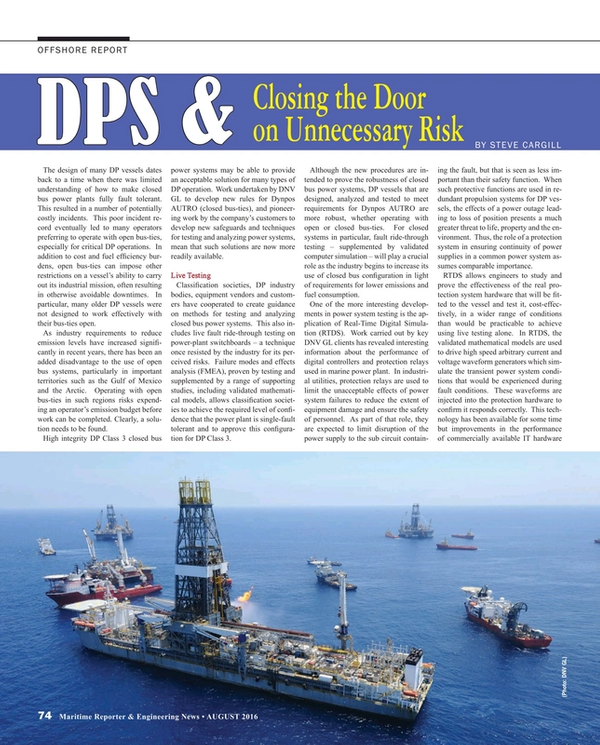The design of many DP vessels dates back to a time when there was limited understanding of how to make closed bus power plants fully fault tolerant. This resulted in a number of potentially costly incidents. This poor incident record eventually led to many operators preferring to operate with open bus-ties, especially for critical DP operations. In addition to cost and fuel efficiency burdens, open bus-ties can impose other restrictions on a vessel’s ability to carry out its industrial mission, often resulting in otherwise avoidable downtimes. In particular, many older DP vessels were not designed to work effectively with their bus-ties open.
As industry requirements to reduce emission levels have increased significantly in recent years, there has been an added disadvantage to the use of open bus systems, particularly in important territories such as the Gulf of Mexico and the Arctic. Operating with open bus-ties in such regions risks expending an operator’s emission budget before work can be completed. Clearly, a solution needs to be found.
High integrity DP Class 3 closed bus power systems may be able to provide an acceptable solution for many types of DP operation. Work undertaken by DNV GL to develop new rules for Dynpos AUTRO (closed bus-ties), and pioneering work by the company’s customers to develop new safeguards and techniques for testing and analyzing power systems, mean that such solutions are now more readily available.
Live Testing
Classification societies, DP industry bodies, equipment vendors and customers have cooperated to create guidance on methods for testing and analyzing closed bus power systems. This also includes live fault ride-through testing on power-plant switchboards – a technique once resisted by the industry for its perceived risks. Failure modes and effects analysis (FMEA), proven by testing and supplemented by a range of supporting studies, including validated mathematical models, allows classification societies to achieve the required level of confidence that the power plant is single-fault tolerant and to approve this configuration for DP Class 3.
Although the new procedures are intended to prove the robustness of closed bus power systems, DP vessels that are designed, analyzed and tested to meet requirements for Dynpos AUTRO are more robust, whether operating with open or closed bus-ties. For closed systems in particular, fault ride-through testing – supplemented by validated computer simulation – will play a crucial role as the industry begins to increase its use of closed bus configuration in light of requirements for lower emissions and fuel consumption.
One of the more interesting developments in power system testing is the application of Real-Time Digital Simulation (RTDS). Work carried out by key DNV GL clients has revealed interesting information about the performance of digital controllers and protection relays used in marine power plant. In industrial utilities, protection relays are used to limit the unacceptable effects of power system failures to reduce the extent of equipment damage and ensure the safety of personnel. As part of that role, they are expected to limit disruption of the power supply to the sub circuit containing the fault, but that is seen as less important than their safety function. When such protective functions are used in redundant propulsion systems for DP vessels, the effects of a power outage leading to loss of position presents a much greater threat to life, property and the environment. Thus, the role of a protection system in ensuring continuity of power supplies in a common power system assumes comparable importance.
RTDS allows engineers to study and prove the effectiveness of the real protection system hardware that will be fitted to the vessel and test it, cost-effectively, in a wider range of conditions than would be practicable to achieve using live testing alone. In RTDS, the validated mathematical models are used to drive high speed arbitrary current and voltage waveform generators which simulate the transient power system conditions that would be experienced during fault conditions. These waveforms are injected into the protection hardware to confirm it responds correctly. This technology has been available for some time but improvements in the performance of commercially available IT hardware means that it is now more cost-effective than ever. Experience from testing has confirmed that the main reasons why power systems fail live fault ride through testing are construction and parametrization errors. Thus, any test process that can be carried out on the real hardware with the actual settings not only increases confidence but also reduces the risk of repeating higher stress tests. Much of the RTDS testing can be done at FAT, reducing the need for additional sea trials time. RTDS can also be cost-effectively used to increase confidence in the robustness of DP Class 2 power plants.
Robust Designs
Verification schemes are considerably more onerous for DP Class 3 closed bus power systems. Typically, they will include the need to analyze, test and mathematically model all possible failure modes that can propagate by way of the bus-ties, as well as to verify that power plant systems are able to withstand the severe disturbance associated with clearing a fault. This requires additional studies and analysis into possible failures, existing and potential protection functions, and back-up protection. Such designs are ‘built to be tested’, adding significantly to confidence levels.
Maintaining integrity in these closed bus systems throughout the vessels’ lifecycle will be the next big focus, and techniques for establishing this is something that the company is currently working on with industry partners. RTDS will almost certainly play an important role in this process. DNV GL is able to provide the mathematical modelling services required to undertake this and similar work. Testing does subject a power plant to a reasonable, although measured, amount of stress and it’s therefore impractical to test every conceivable power level and configuration. Classification societies have agreed a level of testing to be accepted as a starting point, and the company’s mathematical models are validated using that data in order to demonstrate fault tolerance in a full range of approved operating conditions. RTDS is low stress and further enhances the confidence level without adding significantly to the cost and time burden as so much of the work can be done off the critical path. DNV GL’s mathematical power system models are able to drive arbitrary waveform generators and can also be interfaced with other models such as DP and power management system simulators to create a very high degree of realism and confidence in vessel performance.
This type of verification process results in a very robust design which is crucial to industry confidence and is proven to be more effective that any previous verification process. Though it’s a more holistic approach which requires additional effort, the prize is absolutely worth having.
The Author
Steve Cargill is a PhD qualified electrical engineer with almost 30 years’ experience in the electrical engineering, marine and offshore industries including consultancy, academic work and practical applications. He is involved in new building and conversion of all types of dynamically positioned vessels leading to the development of company and industry guidance and standards for the assessment of station keeping integrity.



